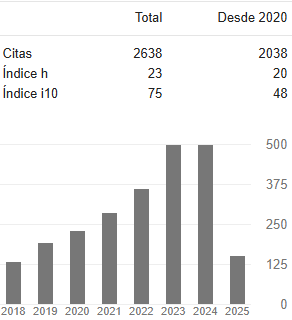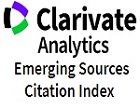Estado del arte de los métodos de evaluación de QoE y entornos de emulación para el servicio de video en redes LTE1
DOI:
https://doi.org/10.31908/19098367.344Palabras clave:
emulación, LTE, modelado, QoS, QoE, tráfico, videoResumen
Este artículo presenta una revisión de los métodos utilizados actualmente para medir la Calidad de la Experiencia - QoE y Calidad de Servicio – QoS para servicio de vídeo usando técnicas de videostreaming a través de un proveedor de servicio de internet, se enuncian las principales diferencias entre las métricas objetivas y subjetivas, escenarios de uso y los inconvenientes presentados en un ambiente inalámbrico. Además, se presenta la tecnología de acceso de radio – RAN Long Term Evolution - LTE como la tecnología inalámbrica con mayor probabilidad de utilización en los próximos años, para lo cual se comparan las herramientas de desarrollo para el manejo de plataformas de emulación para sistemas LTE. Adicionalmente el artículo describe los retos y brechas de investigación en la evaluación y medición de la calidad de la experiencia para servicios de video soportados por tecnologías inalámbricas.
Descargas
Referencias
S. Fowler, et al. “Evaluation and prospects from a measurement campaign on real multimedia traffic in LTE vs. UMTS”, in Wireless Communications, Vehicular Technology, Information Theory and Aerospace & Electronic Systems (VITAE), 2014 4th International Conference on, Aalborg, 2014, pp. 1-5.
A. Lombardo, C. Panarello, and G. Schembra, “A Model-Assisted Cross-Layer Design of an Energy-Efficient Mobile Video Cloud”, Multimed. IEEE Trans. On, vol. 16, n.o 8, pp. 2307-2322, dic. 2014.
Cisco, “Cisco Visual Networking Index: Global Mobile Data Traffic Forecast Update 2014–2019 White Paper”, Cisco, 03-feb-2015. [Enlínea]. Disponible en: http://cisco.com/c/en/us/solutions/collateral/ service-provider/visual-networking-index-vni/white_paper_c11-520862.html. [Accedido: 08-sep-2015].
Ericsson, “Ericsson Mobility Report June 2015”, jun. 2015.
C. N. Pitas, A. D. Panagopoulos, and P. Constantinou, “Speech andVideo Telephony Quality Characterization and Prediction of LiveContemporary Mobile Communication Networks”, Wirel. Pers.Commun., vol. 69, n.o 1, pp. 153-174, mar. 2012.
T. Molloy, Z. Yuan, and G.-M. Muntean, “Real time emulation ofan LTE network using NS-3”, in 25th IET Irish Signals Systems Conference 2014 and 2014 China-Ireland International Conference on Information and Communications Technologies (ISSC 2014/CIICT 2014), Limerick, 2014, pp. 251-257.
T. Stockhammer, “Dynamic adaptive streaming over HTTP: standards and design principles”, in Proceedings of the second annual ACM conference on Multimedia systems, Munich, Germany, 2011, pp. 133-144.
F. J. Rivas, A. Az, and P. Merino, “Obtaining More Realistic Cross- Layer QoS Measurements: A VoIP over LTE Use Case”, J. Comput. Netw. Commun., vol. 2013, pp. 1-10, ago. 2013.
F. Abdurrahman, et al. “Real Time Video Streaming over NS3 based Emulated LTE Networks”, in International Journal of Electronics Communication and Computer Technology (IJECCT), 2014, vol. 4, pp. 659-663.
F. Pianese, J. Keller, and E. W. Biersack, “PULSE, a Flexible P2P Live Streaming System”, in INFOCOM 2006. 25th IEEE International Conference on Computer Communications. Proceedings, 2006, pp.1-6.
D. Ho y H. Song, “Networking cost effective video streaming system over heterogeneous wireless networks», in Personal Indoor and Mobile Radio Communications (PIMRC), 2013 IEEE 24th International Symposium, London, 2013, pp. 3589-3593.
T. Chen,Y. D. and Khalili,R., “MSPlayer: Multi-Source and multi-Path leverAged YoutubER”, in CoNEXT 2014 - Proc. 2014 Conf.Emerg. Netw. Exp. Technol., pp. 263-269, 2014.
D. Munaretto, F. Giust, G. Kunzmann, and M. Zorzi, “Performance analysis of dynamic adaptive video streaming over mobile content delivery networks”, in 2014 IEEE International Conference on Communications (ICC), Sydney, NSW, 2014, pp. 1053-1058.
Y. Guan, Y. Xiao, L. J. Cimini, y C.-C. Shen, “Power efficient peer-to-peer streaming to co-located mobile users”, in Consumer Communications and Networking Conference (CCNC), 2014 IEEE 11th, Las Vegas, NV, 2014, pp. 321-326.
L. Zhang, et al., “Green and Cooperative DASH in Wireless D2D Networks”, Wirel. Pers. Commun., vol. 84, n.o 3, pp. 1797-1816, may 2015.
ITU-T Recommendation Y.1901, “Requirements for the Support of IPTV Services”, 2009.
ITU-T Recommendation E.800, “Definitions of Terms Related to Quality of Service”, 2008.
IETF RFC 2386, “A Framework for QoS-based Routing in the Internet”, 1998.
O. B. Maia, H. C. Yehia, and L. de Errico, “A concise review of the quality of experience assessment for video streaming”, Comput. Commun., vol. 57, pp. 1-12, feb. 2015.
G. Gómez, J. Lorca, R. García, and Q. Pérez, “Towards a QoE-Driven Resource Control in LTE and LTE-A Networks”, J. Comput. Netw. Commun. J. Comput. Netw. Commun., vol. 2013, 2013, ene. 2013.
S. Khorsandroo, R. M. Noor, and S. Khorsandroo, “A generic quantitative relationship between quality of experience and packet loss in video streaming services”, in 2012 Fourth International Conference on Ubiquitous and Future Networks (ICUFN), Phuket, 2012, pp. 352-356.
M. Fiedler, T. Hossfeld, and P. Tran-Gia, “A generic quantitative relationship between quality of experience and quality of service”, IEEE Netw., vol. 24, n.o 2, pp. 36-41, mar. 2010.
D. Tse and P. Viswanath, Fundamentals of Wireless Communication. Cambridge University Press, 2005.
L. Guo and Y. Meng, “What is wrong and right with MSE?”, in Proc. 8th Int. Conf. Signal Image Process. 2006, pp. 212 -215.
S. Chikkerur, V. Sundaram, M. Reisslein, and L. J. Karam, “Objective Video Quality Assessment Methods: A Classification, Review, and Performance Comparison”, Broadcast. IEEE Trans. On, vol. 57, n.o 2, pp. 165-182, jun. 2011.
Z. A. Seghir and F. Hachouf, “Full-Reference Image Quality Assessment Scheme Based on Deformed Pixel and Gradient Similarity”, Opt. - Int. J. Light Electron Opt. DOI 10.1016/j.ijleo.2015.08.132
R. Hong, et al., “Image quality assessment based on matching pursuit”, Inf. Sci., vol. 273, pp. 196-211, jul. 2014.
R. A. Manap y L. Shao, “Non-distortion-specific no-reference image quality assessment: A survey”, Inf. Sci., vol. 301, pp. 141-160, abr. 2015.
J. C. Cuéllar, J. H. Ortiz, and J. L. Arciniegas, “Clasificación y Análisis de Métodos para medir Calidad de la Experiencia del Servicio de Televisión sobre Protocolo IP (IPTV)”, Inf. Tecnológica, vol. 25, n.o 5, pp. 121-128, 2014.
M. Rohani, A. N. Avanaki, S. Nader-Esfahani, and M. Bashirpour, “A Reduced Reference Video Quality Assessment method based on the human motion perception”, in Telecommunications (IST), 2010 5th International Symposium on, 2010, pp. 831-835.
A. Rehman and Z. Wang, “Reduced-Reference Image Quality Assessment by Structural Similarity Estimation”, Image Process. IEEE Trans. On, vol. 21, n.o 8, pp. 3378-3389, ago. 2012.
L. Ma, S. Li, F. Zhang, and K. N. Ngan, “Reduced-Reference Image Quality Assessment Using Reorganized DCT-Based Image Representation”, Multimed. IEEE Trans. On, vol. 13, n.o 4, pp. 824- 829, ago. 2011.
M. Shahid, A. Rossholm, B. Lövström, and H.-J. Zepernick, “Noreference image and video quality assessment: a classification and review of recent approaches”, EURASIP J. Image Video Process., vol. 2014, n.o 1, p. 40, ago. 2014.
S. Winkler and P. Mohandas, “The Evolution of Video Quality Measurement: From PSNR to Hybrid Metrics”, Broadcast. IEEE Trans. On, vol. 54, n.o 3, pp. 660-668, sep. 2008.
I. AL and O. S. AJAYI, “Evaluation of Video Quality of Service in 3G/UMTS Wireless Networks as Succor for B3G/4G Wireless Network”, Master Thesis in Electrical Engineering with Emphasis on Telecommunications, Blekinge Institute of Technology, Karlskrona Sweden, 2010.
C. N. Pitas, and D. Panagopoulos, “Quality of Consumer Experience Data Mining for Mobile Multimedia Communication Networks: Learning from Measurements Campaign”, Int. J. Wirel. Mob. Comput., vol. 8, n.o 1, 2014.
N. Goran, M. Hadžialić, and A. Begović, “Real time assuring QoE in the lowest OSI/ISO layers during delivering of IPTV services”, in 2014 37th International Convention on Information and Communication Technology, Electronics and Microelectronics (MIPRO), Opatija, 2014, pp. 532-535.
M. Fiedler and T. Hossfeld, “Quality of Experience-Related Differential Equations and Provisioning-Delivery Hysteresis”, in The 21st International Teletraffic Congress Specialist Seminar on Multimedia Applications - Traffic, Performance and QoE, Miyazaki, Japan., 2010, pp. 1-6.
A. El Essaili, et al., “Quality-of-experience driven adaptive HTTP media delivery”, in Communications (ICC), 2013 IEEE International Conference, Budapest, 2013, pp. 2480-2485.
J. Seppänen, M. Varela, and A. Sgora, “An autonomous QoE-driven network management framework”, J. Vis. Commun. Image Represent., vol. 25, n.o 3, pp. 565-577, abr. 2014.
S. Jelassi, et al., “Quality of Experience of VoIP Service: A Survey of Assessment Approaches and Open Issues”, Commun. Surv. Amp Tutor. IEEE, vol. 14, n.o 2, pp. 491-513, Second Quarter 2012.
C. N. Pitas, D. E. Charilas, A. D. Panagopoulos, and P. Constantinou, “Adaptive neuro-fuzzy inference models for speech and video quality prediction in real-world mobile communication networks”, Wirel. Commun. IEEE, vol. 20, n.o 3, pp. 80-88, jun. 2013.
The Mobile Broadband Standard, 3GPP a Global Initiative, “Release 8”. [En línea]. Disponible en:http://www.3gpp.org/specifications/releases /72-release-8. [Accedido: 20-oct-2015].
The Mobile Broadband Standard, 3GPP a Global Initiative, Release 9. [En línea]. Disponible en: http://www.3gpp.org/specifications/releases/71-release-9. [Accedido: 20-oct-2015].
The Mobile Broadband Standard, 3GPP a Global Initiative, Release 12. [En línea]. Disponible en: http://www.3gpp.org/specifications/ releases/68-release-12. [Accedido: 20-oct-2015].
The Mobile Broadband Standard, 3GPP a Global Initiative, Release 13. [En línea]. Disponible en: http://www.3gpp. org/ release-13. [Accedido: 20-oct-2015].
Open IPTV Forum, “Release 2 Specification, HTTP Adaptive Streaming”, V2.0, September 2010.
W. Y. Campo, J. L. Arciniegas, R. García, and D. Melendi, “Análisis de Tráfico para un Servicio de Vídeo bajo Demanda sobre Redes HFC usando el Protocolo RTMP”, Inf. Tecnológica, vol. 21, n.o 6, pp. 37-48, 2010.
M. Montagud, F. Boronat, and V. Vidal, “Simulation platform for video streaming evaluation”, in Software, Telecommunications and Computer Networks (SoftCOM), 2010 International Conference on, 2010, pp. 397-401.
D. Buğdaycı, E. Zerman, and G. B. Akar, “Real time streaming of 3D video from embedded platforms to mobile devices”, in Signal Processing and Communications Applications Conference (SIU), 2012 20th, 2012, pp. 1-4.
D. T. Massandy and I. R. Munir, “Secured video streaming development on smartphones with Android platform”, in Telecommunication Systems, Services, and Applications (TSSA), 2012 7th International Conference on, 2012, pp. 339-344.
OPNET. [En línea]. Disponible en: http://www.riverbed.com/products/ steelcentral/opnet.html?redirect=opnet. [Accedido: 28-oct- 2015].
OMNeT++ Discrete Event Simulator - Home. [En línea]. Disponible en: https://omnetpp.org/. [Accedido: 28-oct-2015].
The Network Simulator - ns-2. [En línea]. Disponible en: http://www.isi.edu /nsnam/ns/. [Accedido: 28-oct-2015].
NS-3. [En línea]. Disponible en: https://www.nsnam. org/ . [Accedido: 28-oct-2015].
LTE-Sim. [En línea]. Disponible en: http://telematics.poliba.it /index.php/en/lte-sim. [Accedido: 20-oct-2015].
F. Guidolin, L. Badia, and M. Zorzi, “Implementation of 2x2 MIMO in an LTE module for the ns3 simulator”, in Computer Aided Modeling and Design of Communication Links and Networks (CAMAD), 2012 IEEE 17th International Workshop on, Barcelona, 2012, pp. 281-285.
A. Alvarez, R. et al., “Limitations of network emulation with singlemachine and distributed ns-3”, in Proceedings of the 3rd International ICST Conference on Simulation Tools and Techniques, 2010, p. 67. [59] LENA. [En línea]. Disponible en: http://networks.cttc.es/ mobilenetworks/software-tools/lena/. [Accedido: 20-oct-2015].
G. Xu, G. Lu, and Y. Liu, “Simulating the PCC architecture of LTE networks in OPNET”, in 2013 3rd International Conference on Computer Science and Network Technology (ICCSNT), Dalian, 2013, pp. 902-905.
GNURadio, “GNU Radio wiki - gnuradio.org”. [En línea]. Disponible en: http://gnuradio.org/redmine/projects/gnuradio/wiki. [Accedido: 20-oct-2015].
F. Bellard, “LTE Base Station Software”, Fabrice Bellards website. [En línea]. Disponible en: http://bellard.org/lte/. [Accedido: 20-oct- 2015].
“Amarisoft”. [En línea]. Disponible en: http://www.amarisoft. com/?p=amarilte. [Accedido: 20-oct-2015].
Descargas
Publicado
Número
Sección
Licencia
Derechos de autor 2019 Entre Ciencia e Ingeniería

Esta obra está bajo una licencia internacional Creative Commons Atribución-NoComercial 4.0.



















